Niacan DIY Tutorials
Thanks to Jeanette Price of Niacan Labware ([email protected]) for sharing these tutorials
- Deioniser Convertion from disposable to refillable
- ‘Rolling Rods’ Flemings Left hand Rule demonstrator
- Torque Feeler
- Hoffmann Apparatus
- Heating coils
- Diji pipette handling
Deioniser Cartridge Conversion
Convert your disposable Deminimiser to a refillable one and decimate costs. $99 cartridge (from Liquipro) delivers 235L = $.42/L Refilled cartridge should reduce costs to 9c/L Liquipro claim their resin produces water purer than distilled.
Parts needed from a specialist plumbing supply store; 40mm Nylon test Plug, 8mm x1/2 BSP Swivel connector. Total one-off costs of $28 to set up. (Prices from 2014)
Liquipro refill pack, 1L MB400IND (INDICATING resin). 1L pack is sufficient for about 1 1/2 fills 4L pot reorder no “SMO462 Indicating resin” from Liquipro $112+. ([email protected]) Recharge costs are therefore about $18/ fill.
Also need a new mesh to hold the resin in place. I cut a 40mm circle of filter fabric for aquariums. (Looks to me identical to standard thin dacron upholstery padding). The connector does not directly fit the white tubing of the deioniser, so I added a 20mm length of 10mm o.d. tubing, before forcing on the white tubing. This tubing will not be removed again when the column is refilled; only the big white wing nut needs to be unscrewed. Cut the top off your old deminimiser unit (the end distant from the label!) with a hacksaw or best on a band saw. (Get a nice square cut by wrapping a piece of A4 paper very tidily around the column, lining up the overlapping edges perfectly. This ensures a perfect 90degree cutting guide)
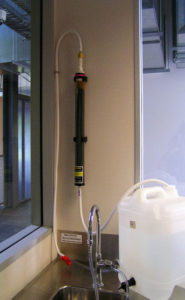
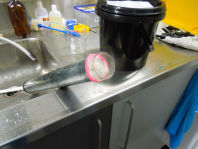

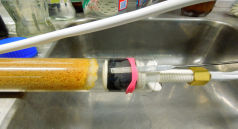
Clean up the cut edge carefully, so it won’t cut the rubber washer of the new fitting. Mark a line about 38mm from the top to indicate a ‘fill” level for the new resin. Load the new resin, giving the cylinder a sharp knock after each 3 tablespoons to consolidate the resin as much as possible. I work over the sink and hold the cylinder vertical while knocking on the bench edge. When it seems full, rinse the resin down with about 200ml of water to further consolidate it. Add the filter then the plug. I tighten the unit just hand tight, but do check there are no leaks before leaving the unit running!
The new fitting has no flange at the top to stop the cartridge slipping down out of the wall mounting clips so I added a rubber band. Take great care of your pot or bag of resin – close it up as quickly as possible, sealing air off the surface or it will go orange (expired). I bought a 4L pot and I found a solid plastic lid that that fits inside the resin pot. I press this inner lid down firmly over a piece of gladwrap to exclude as much air as possible from the surface of the resin. You might notice from the tall picture that the white inlet tubing of the deioniser is not attached to the tap but rather to a red clip. This is part of my burette washer and is the same tubing I used as a packer between white tube and the new connector. I never have to change the tubing on the tap itself.
Refilling the unit: This should take only about 10 minutes. If the plug does not come free easily it may be because the black plug has become stuck to the tube. This is easily remedied by running a blunt spatula carefully around the bung, being careful not to cut the rubber.
If you like the idea of saving the planet from some landfill and saving your school lots of dollars, but don’t have the time or tools to do this then get in touch and I can do the conversion for you.
Torque Feeler
Make this from 2 lengths of dowel, one about 10mm diameter and about 250mm long, the other, the handle, considerably thicker, about 20mm diameter and 2 hand widths long -about 220mm. We used pvc tubing 21mm o.d. for the handle. Hang on any heavy mass and slide it up and down to get the feel of torque.
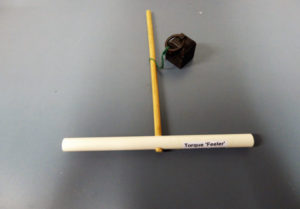
‘Rolling Rods’ Flemings Left Hand Rule demonstrator
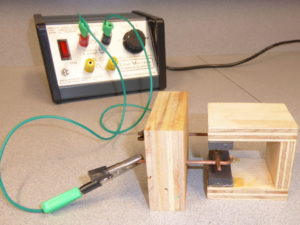
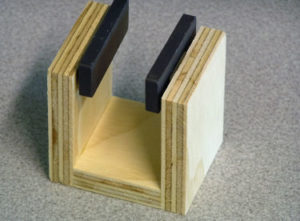
Heavy copper rods with hooked ends support another copper rod with a flagged end. When placed in a magnetic field the direction of movement shows the direction of force.
The rods store tidily within the block for compact storage, and obvious that all parts have been returned. Rod holder blocks are 70x78x25mm. Drill 2 holes 50 mm apart on the centre line. Drill 3 x 3mm holes almost the entire length of the block for storage.
Rods are 2.5mmx80mm long. Hook rod is 2.5mmd. x 85mm long with 5mm bent up at the end 2.5mm rod should withstand most handling without becoming bent.
Block magnets (50x19x6)are glued into the wooden yoke, made from 12mm plywood. Bottom piece is 43x 52mm. Sides 65x52mm. Glue and pin the joint.
The hard part is finding the copper rod.
Hoffmann apparatus
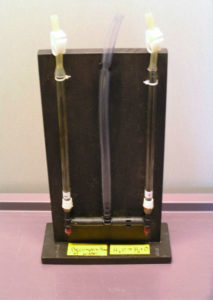
A short notice request for a Hoffman apparatus resulted in this simple construction. Even when we got a ‘real’ one we still preferred this version for its robustness and simplicity.
- Tubing is broken Diji pipets with silicon tubing over the tips with tubing clamps.
- Fittings needed;
- 3 x Plassay irrigation system 3way jointers
- 2 x short lengths of irrigation tubing to join the 3 way jointers.
- 2 x one-hole rubber bungs hold graphite electrodes pushed through with just enough left protruding for a crocodile clip to the power supply.
- The joint to between Diji and 3 way connector uses silicone adhesive.
- The centre tube is longer than the dijis and would benefit from even more length or a collection vessel added, as the water level rises here as gas is accumulated above the electrodes.
- Tubing is held to the backing board using cable ties.
I have identified + and – electrode only because the unit is often run in the technician area then transferred to the lab in order to get increased gas volumes. Don’t use pure water in this apparatus. A little bicarbonate hastens gas formation.
Heating Coils
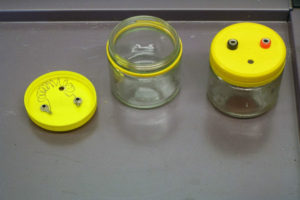
Durable units that don’t tangle together are made from Vegemite jars. About 40cm of heavy gauge Nichrome wire with 14 tight wraps around a pencil, soldered to banana plug washers. Drill 2 holes for the banana plugs and another for a thermometer.
How to preserve Diji pipettes
Breakable gear needs careful treatment, so to encourage students that way I have tried to give visual prompts like special packaging. Ideally I am only inconvenienced once with set up, but the benefits are ongoing.
During our first year using Dijis the number of broken tips was quite depressing . However, progressive changes have paid dividends with very few breakages this year.
Below, you see clean Dijis stored in Gratnel trays lined with nonslip drawer liner with black foam plastic cut with a bevel on top for the handles. The black foam is attached to the tray with double sided sellotape on the vertical surface. The tips slide under the foam.

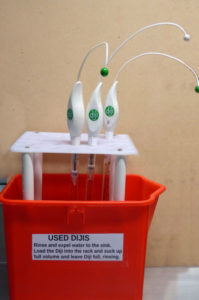

We do not depend on students to rinse pipettes thoroughly after use. We have students leave pipets rinsing in a bucket with water drawn up fully. Initially, we used just a short bucket, but then we glued foam mesh drawer liner to the bottom. Finally, I have made a rack so the tips do not contact the bottom of the bucket at all.
The technician gives the Dijis 2 more rinses, which is also an opportunity to notice any leaks.
My latest improvement has been to make a rack for the wash bucket, to stop Dijis knocking together and lift the tips off the bottom of the bucket. Below is a build your own guide. This rack holds 35 Diji pipets.
- Cut the top from a plastic cutting board 235x175mm.
- 16mm holes are space at 35 mm centres.
- Drill holes with a forstner bit -spade bits give very ragged holes.
- Legs are 295 long.
This mop bucket has a 20mm deep finger indent in the bottom. For a flat bottomed bucket legs need only be 275mm. Dowels 50mm long are inserted into the leg tubing, flush cut on the band saw, then screwed through the top in countersunk holes (to prevent damage to Diji tips).
Jeanette Price, Niacan Labware ([email protected])
